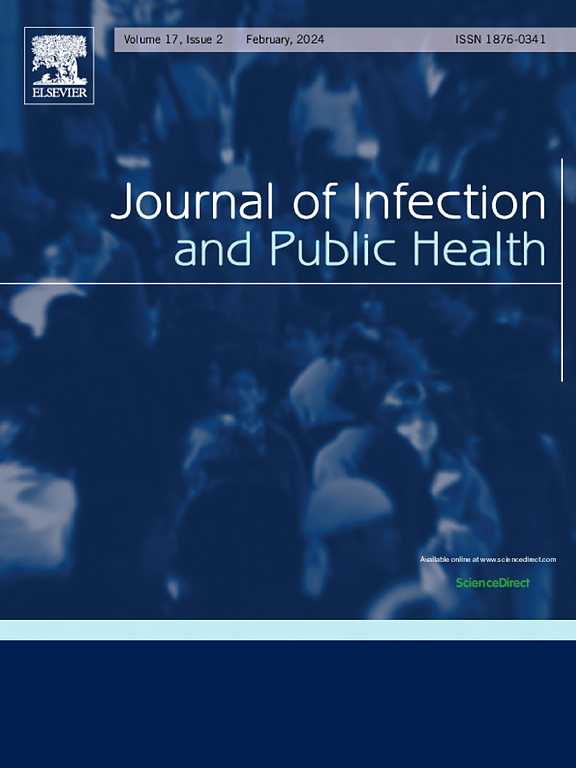新冠肺炎发生后日本社会接触模式的时间趋势
IF 4.7
3区 医学
Q1 INFECTIOUS DISEASES
引用次数: 0
摘要
背景:截至2022年,日本的社会接触数据显示,与新冠肺炎大流行前相比,接触人数大幅减少。然而,目前尚不清楚,在疫情防控措施结束后,社会接触是否会继续减少。在日本,关于流感样疾病(ILIs)对社会接触的影响的证据也很少。因此,本研究审查了大流行期间接触频率的减少是暂时的还是持续到今天,并评估了ILIs对社会混合模式的影响。方法:从2022年到2024年,我们对有ILIs症状的个体进行了定期的在线问卷调查,比较他们患病期间和患病后每天的接触次数。从调查数据中获得接触矩阵。使用负二项回归分析检验了调查时间和ILIs的影响。结果:2022年3月至2024年6月,接触方式基本呈年龄分类,平均接触次数逐渐增加。最近,患病期间每天接触人数中位数为3人(四分位数区间[IQR] 2-7),康复后上升至4.5人(IQR 2-11)。先前的调查和ili显示与社会接触频率呈负相关。结论:与2021年相比,日本社会接触频率有上升趋势,但尚未达到大流行前水平。当个体出现由ili引起的症状时,他们倾向于减少接触。本文章由计算机程序翻译,如有差异,请以英文原文为准。
Chronological trend of social contact patterns in Japan after the emergence of COVID-19
Background
The social contact data for Japan as of 2022 showed a substantially decreased number of contacts compared with before the COVID-19 pandemic. However, it is unclear whether social contact continues to be depressed following the end of countermeasures against the pandemic. There is also scarce evidence regarding the influence of influenza-like illnesses (ILIs) on social contacts in Japan. Therefore, this study examined whether the reduction in contact frequency during the pandemic was temporary or persists today and assessed the impact of ILIs on social mixing patterns.
Methods
We conducted online questionnaire surveys of individuals who experienced symptoms of ILIs periodically from 2022 to 2024 to compare the number of contacts per day during and after their illnesses. Contact matrices were obtained from the survey data. The impacts of the timing of the survey and the ILIs were examined using negative binomial regression analysis.
Results
Contact patterns were generally age-assortative, and the average contact numbers gradually increased from March 2022 to June 2024. Most recently, the median number of contacts per day during illness was 3 (interquartile range [IQR] 2–7) and then rose to 4.5 (IQR 2–11) after recovery. The earlier survey and ILIs showed a negative association with the frequency of social contacts.
Conclusion
The frequency of social contacts in Japan tended to rise compared with that in 2021 but has not yet reached pre-pandemic levels. Individuals tended to decrease their contacts when they had symptoms caused by ILIs.
求助全文
通过发布文献求助,成功后即可免费获取论文全文。
去求助
来源期刊

Journal of Infection and Public Health
PUBLIC, ENVIRONMENTAL & OCCUPATIONAL HEALTH -INFECTIOUS DISEASES
CiteScore
13.10
自引率
1.50%
发文量
203
审稿时长
96 days
期刊介绍:
The Journal of Infection and Public Health, first official journal of the Saudi Arabian Ministry of National Guard Health Affairs, King Saud Bin Abdulaziz University for Health Sciences and the Saudi Association for Public Health, aims to be the foremost scientific, peer-reviewed journal encompassing infection prevention and control, microbiology, infectious diseases, public health and the application of healthcare epidemiology to the evaluation of health outcomes. The point of view of the journal is that infection and public health are closely intertwined and that advances in one area will have positive consequences on the other.
The journal will be useful to all health professionals who are partners in the management of patients with communicable diseases, keeping them up to date. The journal is proud to have an international and diverse editorial board that will assist and facilitate the publication of articles that reflect a global view on infection control and public health, as well as emphasizing our focus on supporting the needs of public health practitioners.
It is our aim to improve healthcare by reducing risk of infection and related adverse outcomes by critical review, selection, and dissemination of new and relevant information in the field of infection control, public health and infectious diseases in all healthcare settings and the community.
 求助内容:
求助内容: 应助结果提醒方式:
应助结果提醒方式:


